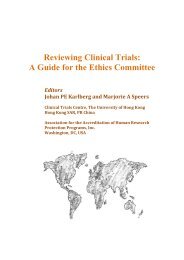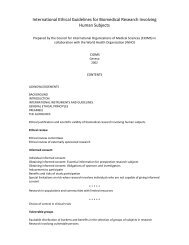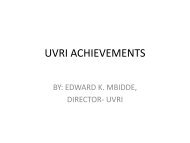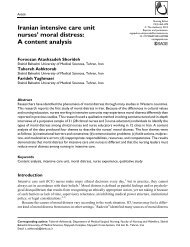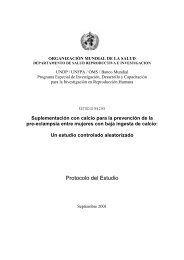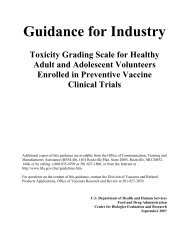03-00 THERAPY CHAPTER – INTRODUCTION - Global Health Trials
03-00 THERAPY CHAPTER – INTRODUCTION - Global Health Trials
03-00 THERAPY CHAPTER – INTRODUCTION - Global Health Trials
You also want an ePaper? Increase the reach of your titles
YUMPU automatically turns print PDFs into web optimized ePapers that Google loves.
To begin with, you want monitors who are expert in the functions you listed in the previous step.<br />
Their collective expertise must extend from the clinical presentation and care of patients with the<br />
target disorder to the latest developments in trial design and statistical analysis.<br />
Paradoxically, we usually exclude the most knowledgeable clinician, the Principal Investigator,<br />
from the monitoring process. In recognition of this paradox, Curt Meinert has challenged the<br />
notion that the PI must be kept blind to the emerging results 5 . Scenario #4 describes a partial<br />
solution to this paradox in which the triggering of a statistical warning rule leads monitors to<br />
unblind the PI, not stop the trial.<br />
Monitors’ experience in the conduct and monitoring of RCTs must be sufficient for them to have<br />
previously confronted all the problems you envisage in your trial, especially in the consideration of<br />
early, unstable trends in efficacy and safety. Stopping an RCT early for a trend in efficacy or<br />
safety that subsequently disappears is every trialist’s nightmare.<br />
Avoiding conflicts of interest (whether real or potential) among trial monitors is vital to both the<br />
validity and the credibility of your or anybody else’s RCT. Some conflicts are obvious; others are<br />
subtle. Table <strong>03</strong>-16-3 lists the ones the DAMOCLES gang and I could think of. Note that most of<br />
them apply as well to the authors of the letters, editorials, and guidelines that appear following the<br />
publication of the trial results.<br />
Table <strong>03</strong>-16-3: Real and potential conflicts of interest for monitors<br />
Owns stock in the company that stands to gain from a positive trial of their product<br />
Financial or process.<br />
Owns stock in a competing company that stands to lose from a positive trial of the<br />
product or process.<br />
Buys stock in the former company, or sells stock in the latter, based on unblinded<br />
data available only to monitors.<br />
Is a paid consultant or honorarium recipient of either company.<br />
Receives research or educational grants, fellowship support, or free travelaccommodation<br />
from either company.<br />
Receives payment beyond reimbursements for travel to, and accommodation at,<br />
monitoring meetings (Exception: income offsets for time spent by some university<br />
and government employees in monitoring, paid to their employers.)<br />
Career success is tied to applying the product or process.<br />
Professional Is (or will be) admitting patients to the RCT.<br />
Is involved in running any part of the RCT.<br />
Is a member of the regulatory agency that will approve/disapprove the product or<br />
process.<br />
Is a member of the funding agency whose prestige and budget will be affected by<br />
the outcome of the RCT.<br />
Already on record as certain about the efficacy and safety (good or bad) of the<br />
Academic experimental treatment.<br />
Would get credit for authorship of publications arising from the RCT.<br />
The final entry in Table <strong>03</strong>-16-3 stresses the “servant” role of monitors. They should seek neither<br />
fame nor publications for their efforts. They have to get all the satisfaction they need from<br />
working and learning behind the scenes, with nothing to show for it but an acknowledgement in<br />
small print at the end of a publication.<br />
Page 4 of 7




